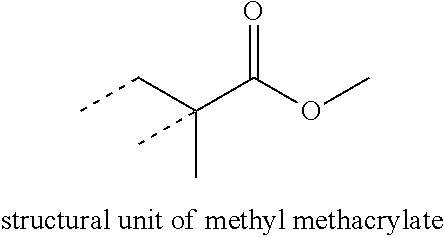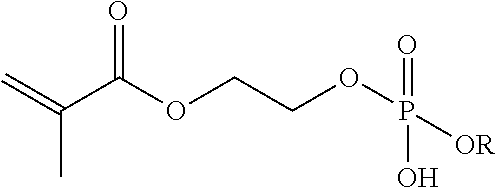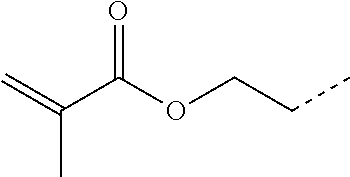Latex functionalized with phosphorus acid and photoinitiator groups
a technology of phosphorus acid and phosphorus acid, applied in the direction of coatings, etc., can solve the problems of benzophenone, leaching over time, and most paints lose a significant amount of gloss, and achieve the effect of improving gloss
- Summary
- Abstract
- Description
- Claims
- Application Information
AI Technical Summary
Benefits of technology
Problems solved by technology
Method used
Image
Examples
example 1
Preparation of 2-Stage Latex: Photoinitiator Monomer and Phosphorus Acid Monomer Added in the First Stage
[0023]A first monomer emulsion was prepared by mixing deionized water (195 g), Disponil FES-993 surfactant (29.2 g, 30% active), 2-ethylhexyl acrylate (155.0 g), butyl acrylate (99.4 g), methyl methacrylate (227.2 g), phosphoethyl methacrylate (39.2 g, 60% active), methacrylic acid (4.6 g), and 2-hydroxy-3-(methacryloyloxy)propyl 2-benzoylbenzoate (38.3 g). To a 5-L, four-necked round bottom flask equipped with a paddle stirrer, a thermometer, nitrogen inlet, and a reflux condenser was added deionized water (929.2 g) and Disponil FES-32 surfactant (11.2 g, 31% active). The contents of the flask were heated to 83° C. under N2 and stirring was initiated. A portion of the first monomer emulsion (112 g) was then added followed by a rinse of deionized water (40 g). A solution of ammonium persulfate (3.76 g) dissolved in deionized water (20 g) was added to the flask followed by a rinse...
example 2
Preparation of 2-Stage Latex: Photoinitiator Monomer and Phosphorus Acid Monomer Added in the Second Stage
[0024]A first monomer emulsion was prepared by mixing deionized water (307 g), Disponil FES-32 surfactant (20.5 g, 31% active), 2-ethylhexyl acrylate (206.7 g), butyl acrylate (139.8 g), methyl methacrylate (415.2 g), and methacrylic acid (3.8 g). To a 5-L, four necked round bottom flask equipped with a paddle stirrer, a thermometer, nitrogen inlet, and a reflux condenser was added deionized water (929.2 g) and Disponil FES-32 surfactant (11.2 g, 31% active). The contents of the flask were heated to 83° C. under N2 and stirring was initiated. A portion of the first monomer emulsion (112 g) was then added followed by a rinse of the flask with deionized water (40 g). A solution of ammonium persulfate (3.76 g) dissolved in deionized water (20 g) was added to the flask followed by a rinse of deionized water (5 g). After the maximum exotherm was observed, the remainder of the first m...
example 3
Preparation of 2-Stage Latex: Photoinitiator Monomer, Phosphorus Acid Monomer, and Ureido Methacrylate Added in the First Stage
[0030]A first monomer emulsion was prepared by mixing deionized water (139 g), Disponil FES-993 surfactant (28.2 g, 30% active), 2-ethylhexyl acrylate (158.8 g), butyl acrylate (96.4 g), methyl methacrylate (230.2 g), phosphoethyl methacrylate (39.2 g, 60% active), methacrylic acid (4.7 g), and 2-hydroxy-3-(methacryloyloxy)propyl 2-benzoylbenzoate (72.6 g, 54% active). To a 5-L, four-necked round bottom flask equipped with a paddle stirrer, a thermometer, nitrogen inlet, and a reflux condenser was added deionized water (931 g) and Disponil FES-32 surfactant (11.9 g, 30% active). The contents of the flask were heated to 8° C. under N2 and stirring was initiated. A portion of the first monomer emulsion (116.1 g) was then added followed by a rinse of deionized water (32 g). A solution of ammonium persulfate (4.0 g) dissolved in deionized water (26 g) was added ...
PUM
| Property | Measurement | Unit |
|---|---|---|
| weight percent | aaaaa | aaaaa |
| weight percent | aaaaa | aaaaa |
| weight percent | aaaaa | aaaaa |
Abstract
Description
Claims
Application Information
 Login to View More
Login to View More - R&D
- Intellectual Property
- Life Sciences
- Materials
- Tech Scout
- Unparalleled Data Quality
- Higher Quality Content
- 60% Fewer Hallucinations
Browse by: Latest US Patents, China's latest patents, Technical Efficacy Thesaurus, Application Domain, Technology Topic, Popular Technical Reports.
© 2025 PatSnap. All rights reserved.Legal|Privacy policy|Modern Slavery Act Transparency Statement|Sitemap|About US| Contact US: help@patsnap.com



